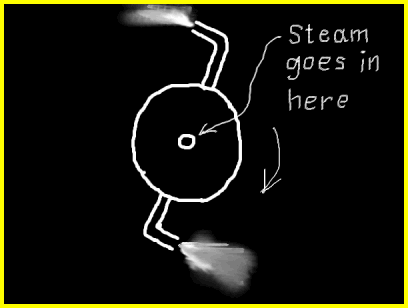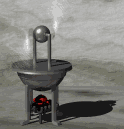2
Benjamin’s Blue Steam
Miss Tumble brought the kettle
from the teachers’ room into class and boiled
water so that the children could all look at steam
coming out of the spout. Everybody stayed at their
places because boiling water and steam were very
dangerous.
Marjorie said that she had a
kettle at home that could whistle. This special
whistling kettle had a whistle attached to the
spout. Marjorie’s mum or dad had to take off
the whistle in order to fill the kettle from the
tap. They placed the whistle back on the spout and
put the kettle on the gas cooker to boil. When the
water boiled, steam came out of the spout and
through the whistle. The kettle whistled loudly
until Marjorie’s mum or dad turned off the
gas. Marjorie said it was great because everyone in
the house could hear when the kettle had boiled.
Her mum or dad didn’t have to stand watching
it to know when the water would be ready to make
tea.
The kettle from the
teachers’ room didn’t have a whistle.
Miss Tumble said it contained a sensor that turned
off the electricity automatically once the water
had boiled and steam started to form. Otherwise the
kettle could have continued to boil until all the
water had been turned into steam by
evaporation.
If that had happened, the
classroom would have been turned into a sauna.
Everybody laughed at the thought of the classroom
becoming a sauna, especially Tom. Freddie
didn’t laugh so much because he preferred condensation
to evaporation.
For thousands of years before
electricity had been discovered, people boiled
water by heating it in pots or kettles. They needed
the hot water to cook food, or perhaps to make tea
(the Chinese did this). They weren’t very
interested in the steam that was produced, but once
the steam appeared they knew that the water was as
hot as it could become. Occasionally people may
have noticed that the steam from boiling water
could lift the lid of a pot, but did not think too
much about it. If they tried heavier lids that
fitted tightly, the steam lifted them too. The
solution to the lifting lid problem was to ensure
that the steam was not restricted too much from
escaping. Putting a hole in the lid or making sure
it was not a close fit prevented the lid from
lifting. Maybe lots of different people thought of
using the effect of the steam pushing on a lid to
do useful work. If so, the idea did not catch on
for a long time – not until the early part of
the eighteenth century, in fact.
A man called Hero, who lived
in Alexandria more than two thousand years ago,
invented a toy that was good fun and worked on
steam. He made a hollow metal ball that could
rotate about an axle. To this he attached two bent
tubes that pointed in opposite directions, rather
like the ends of the letter Z. He let steam flow
into the ball from a vessel like a kettle that was
heated over a fire. The steam entered the ball
through the axle, which was hollow. It left
the ball through the bent tubes and caused it to
spin around quite fast. This was quite a novelty
and was great to watch. It is a pity that Hero did not
think of using the motion for something useful, like
driving a children’s merry-go-round.
 Hero's Turbine – as drawn by Miss Tumble
Hero's Turbine – as drawn by Miss Tumble
In fact Hero had invented a
baby steam
turbine. Eventually it ‘grew up’ and
became the powerful turbines that are used today
for making electricity or powering aircraft.
The children had all studied
shapes like circles, rectangles, squares,
triangles, spheres and cubes. Miss Tumble did not
have to remind them that the metal ball of
Hero’s machine was a sphere. As a test, Miss
Tumble asked the class what was the name for a half
sphere. Eve, Freddie, Benjamin and Tom all
put up their hands. She asked Tom first and he said
it was a semi-sphere. Miss Tumble said that was a
good answer, but stated that another term was
generally used; so she asked Eve next. Eve said a
half sphere was known as a hemisphere. Yes, that
was the usual name for a half sphere, according to
Miss Tumble. She thanked Eve and wrote HEMISPHERE
on the blackboard. Tom whispered to Coleman that
hemisphere had only ten letters in it.
According to Miss Tumble, the
technical name for the kettle-like vessel that
produced the steam was a
boiler. The name for the part that spun around was a
turbine. Much of the electricity produced in
Ireland and in the world was produced by steam
turbines. Robert, Benjamin’s twin brother,
wanted to know how the rest of the electricity was
produced. Miss Tumble wasn’t sure about that.
She said she thought some
 of the electricity was produced by water turbines like the ones
on the River Shannon at Ardnacrusha, or on the River
Liffey at Leixlip.
Later Benjamin won a prize of a
spider plant for copying a picture of
Hero’s turbine from the blackboard and
colouring it in. He showed the steam as blue. Miss
Tumble said that was OK because white would not
have shown up against the paper of his copybook.
of the electricity was produced by water turbines like the ones
on the River Shannon at Ardnacrusha, or on the River
Liffey at Leixlip.
Later Benjamin won a prize of a
spider plant for copying a picture of
Hero’s turbine from the blackboard and
colouring it in. He showed the steam as blue. Miss
Tumble said that was OK because white would not
have shown up against the paper of his copybook.

Hero's Turbine:
the Aeolipile
